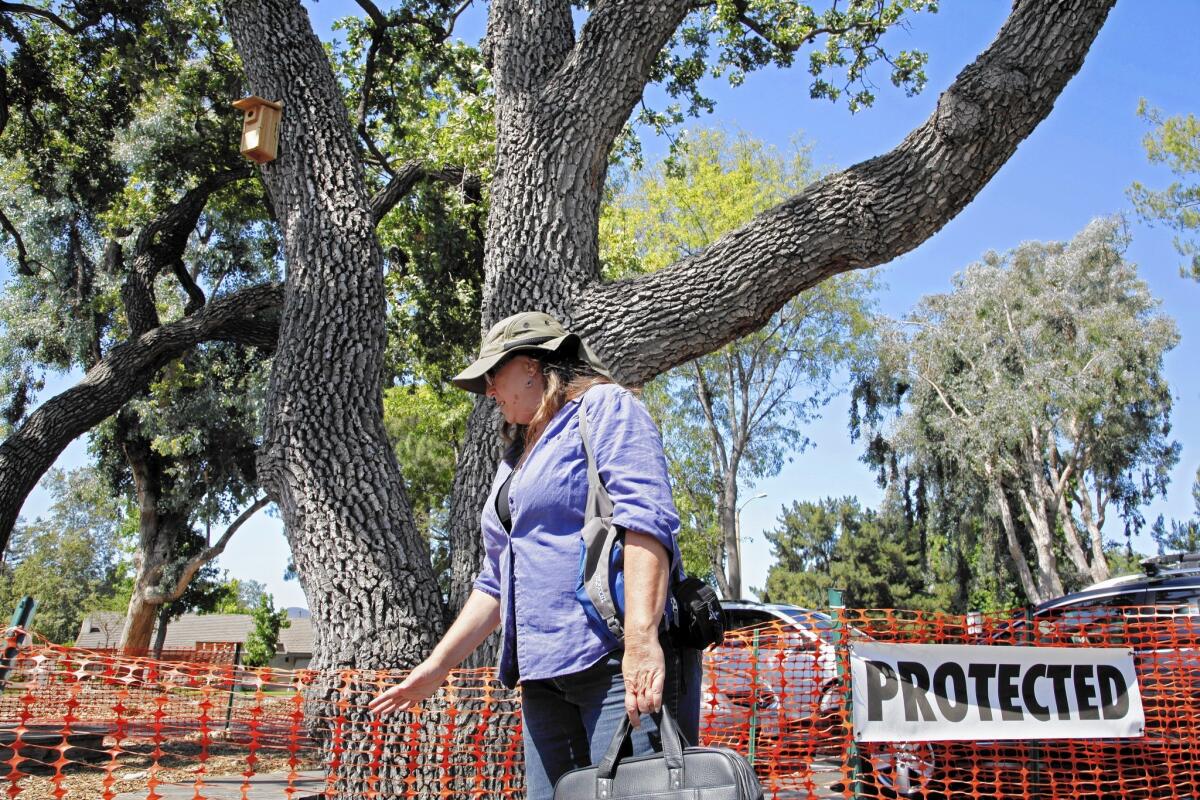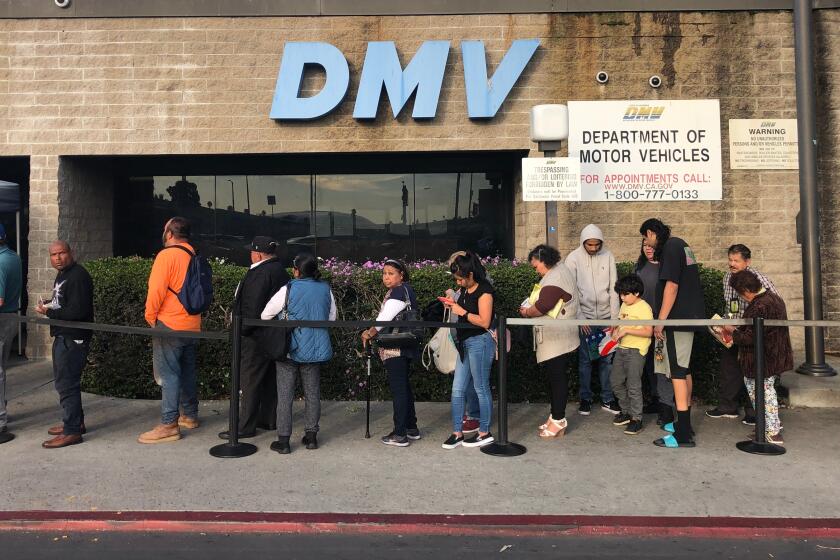Thousand Oaks redevelopment sparks public outcry to save the trees

- Share via
There are trees, and then, when you grow up in a city called Thousand Oaks, there are trees.
The oak tree isn’t just in the city seal; it’s in the city’s DNA. When Yvonne Brockwell was growing up, the trees were ingrained in her schooling. She learned how the native Chumash people once used heated stones to make acorn soup, how the Spaniards used towering oaks as landmarks during exploration, how the trees were taken into consideration and preserved while orchards and chicken farms gave way to a well-heeled suburb.
“This is our heritage,” said Brockwell, 48, who was so inspired she later became a trained arborist. “We were taught that these trees meant so much to us. It formed me, and it formed a lot of people in our area.”
So earlier this year, when the owner of a prominent shopping center began chopping down more than 170 trees to make way for progress, Brockwell and many other residents had the same response: “This has to be illegal.”
But it wasn’t. Today, a movement is underway to make sure that it will never happen again, that the Westlake Plaza trees didn’t die in vain, that the oaks of Thousand Oaks will be protected — like most people assumed they were, before learning the hard way that they were wrong.
Peppered with million-dollar homes, leafy and verdant, part of the metropolis but on its fringe, Thousand Oaks has always viewed itself as a special place.
That sheen extended even to its shopping centers. Westlake Plaza was a community hub, a place where local businesses — such as Sweet Arleen’s, a boutique bakery known nationally for its victories on the TV show “Cupcake Wars” — stuck it out amid the usual chain stores. Kids rode their bikes there for ice cream, and many got their first job there; Brockwell earned $3.15 an hour working for a stationery shop when she was 16.
But portions of the shopping center hadn’t been touched since the 1970s, and there was a growing sense that its age was showing. Several years ago, the shopping center, by then owned by Jacksonville, Fla.-based Regency Centers Corp., started piecing together plans for a $25-million face-lift.
It was an ambitious undertaking. Three abutting shopping areas would be unified with walking paths, a streamlined traffic flow and signage. About 8,000 square feet of space would be added, bringing the total to roughly 280,000 feet, and new tenants would be welcomed — Mendocino Farms, Le Pain Quotidien, a yoga studio, a juicery.
Then there was the matter of the trees. There were hundreds of them throughout the property, some of them stately oaks that were centuries old. A smattering of smaller trees had been removed during the earlier phases of the redevelopment, but then, one day in April, the felling really began.
The trucks rolled in, the sound of power saws caromed through the development and the limbs starting coming down, followed by meaty trunks. Residents began gathering, taking photographs and trying to corral squirrels that raced down from the trees and zigzagged, disoriented, through the parking lot.
“It was a military maneuver,” Brockwell said. “It was devastating.”
The shopping center’s redevelopment plan included the removal of more than 200 trees, with plans to replace them with fresh plantings and landscaping and reconfigure outdoor areas to ensure that trees would not “damage the center’s improvements and infrastructure,” Regency Centers said in a statement to The Times. To date, at least 170 trees have been cut down.
City Hall staff had approved the plan, but neither the city Planning Commission nor the City Council was notified. The public was never told.
The shopping center planned to chop down three “native” oak trees — those that existed before the land was developed and were considered hallmarks of the local landscape. Chopping down four trees in that category would have triggered a public hearing.
Dozens of the targeted trees required City Hall staff approval for removal, and the permit was granted after the shopping center made the case that those trees were either in poor health or were potential hazards. But critics have said that they saw no signs of disease or rot as those trees came down.
Particularly galling to the public was that the majority of the trees that were being removed didn’t have any protection under city ordinances, the result of a 2010 exemption that was created to allow the removal of any oak tree, of any size or age, if it had been planted by the property owner.
The trees that were removed and fell under this category were planted by the original owners of the shopping center. But that was decades ago, and by now many of those trees were quite large. To the public, it was difficult to differentiate between “native” trees and “owner-planted” trees.
“They followed the law,” said Thousand Oaks City Councilwoman Claudia Bill-de la Pena, the only member of the council who voted against the 2010 exemption. “But at some point in a tree’s life, it shouldn’t matter whether the tree was planted by nature or by a property owner.”
The public outcry was swift.
“At first, the community was really mad at Regency,” Brockwell said. “But ultimately, this falls on our city. This is the fault of our city. Rather than working around the trees, which the city used to do, now the city does whatever it needs to do to please the developer.”
The reaction left Regency Centers and city officials reeling — and scrambling to make changes.
The redevelopment plans were quickly altered. A number of trees have been spared from the saw and removed from the proposal, such as four large “landmark” sycamore trees. The shopping center also agreed to move up the schedule of replanting to shorten the amount of time that the site would look barren after all of the tree removals.
And now, an effort is gaining speed to ensure that this never happens again.
The same City Council that approved the 2010 exemption for owner-planted trees has voted unanimously to put a moratorium on that ordinance change, prohibiting City Hall officials from permitting tree removal under that provision. The moratorium will be in place for 10 more months.
The city is appointing a special commission of residents, property owners and business owners who will meet during that time to overhaul the approach to protecting large trees, including not only oaks, but black walnuts, sycamores and more, said Bill-de la Pena.
“What happened was a shock to everyone,” she said. “We knew we had to take action.”
Meanwhile, Regency Centers says the redevelopment of the shopping center “has caused a large increase” in its leasing. The center is at nearly 100% occupancy.
“We’re focusing our efforts on upgrading the overall experience, and moving forward on a path that celebrates Westlake Plaza’s uniqueness in the region,” the company said in a statement. “Regency Centers shares the same appreciation and passion as the community does for the landmark trees.”
Twitter: @scottgoldLAT
More to Read
Sign up for Essential California
The most important California stories and recommendations in your inbox every morning.
You may occasionally receive promotional content from the Los Angeles Times.











